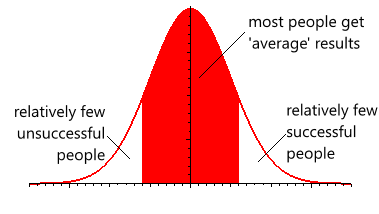The most significant book that I read last year and the one that really turned the lights on for me, was The Slight Edge, by Jeff Olsen.
It explains the difference between those people who seem to have it all, and those who don’t – and it explains it in terms of the small, seemingly insignificant but consistently regular actions that successful people take.
Importantly, it shows that these actions are not particularly difficult in themselves to do, but unfortunately they are easy not to do as well. Sadly, for most people, this simple fact is the reason they don’t do these actions. Success is the resulting accumulation of all these action that have been performed consistently.
Whether it’s a little daily exercise, or telling your spouse you love them every day, or saving a little money from each pay packet, it’s the regularity and consistency that leads to success.
They say “an apple a day keeps the doctor away”. You can’t eat 5000 apples the day you find out you have bowel cancer and think it’s all going to be OK. It’s just too late then.
And of course, it applies to success at everything – relationships, wealth, health, work and wisdom and more.
I think the most interesting idea in the book is the idea that you’re on one of two curves. You’re either on the good curve – where you are doing the regular positive actions that compound so that the benefits start to go exponential – like compound interest. Or you are on the bad curve – where negative actions compound negatively. BTW there is no ‘neither’. Doing nothing is the bad curve.
So clearly, this book is all about how good habits cause success to accelerate over time. One message I took from it is that if I want to be more productive, I need to perform a positive productivity action every day. It needs to be a habit. A Productivity Habit.
My first productivity habit was simply to track the activity in each of the areas of my life that I wanted some movement in.
For example, I ruled up a diary that I update each night like this:
| |
Health |
Wealth |
Wisdom |
Relationships |
Work |
| Monday |
|
|
|
|
|
| Tuesday |
|
|
|
|
|
| Wednesday |
|
|
|
|
|
| Thursday |
|
|
|
|
|
| Friday |
|
|
|
|
|
| Saturday |
|
|
|
|
|
| Sunday |
|
|
|
|
|
Before I go to sleep, I update it with the positive actions that I took that day in each area. It’s a simple thing, but I can immediately see when I’ve dropped the ball somewhere. Easy to do, easy not to do.
It sounds a bit dorky, doesn’t it? Well too bad. Since I’ve started doing this I’ve noticed how much the areas with the most activity have started to improve.
Most people don’t consciously attend to this kind of activity. Most people end up with average health at best, average relationships at best and average wealth at best. Remember, doing nothing is on the negative curve.
I don’t want to end up like most people, so I’m working myself away from average one daily action at a time.
Recommendation: Buy the book.

 For any activity – golf, business, financial management, karate, poker, art, work, music etc – there’s a small number of people doing it who are not good at it at all, a large number of people who are average at it and a small number of people who are extremely good at it.
For any activity – golf, business, financial management, karate, poker, art, work, music etc – there’s a small number of people doing it who are not good at it at all, a large number of people who are average at it and a small number of people who are extremely good at it.
 What could YOU do with your life if you had just a few more hours each day?
What could YOU do with your life if you had just a few more hours each day?